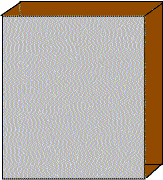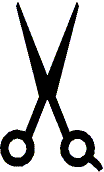
Fume Hood

Most importantly, safety is a concern in any necropsy situation. By using a fume hood, you are protecting yourself from any inhalants from the animal or preservatives. Keep the work area clean by washing it down with ethanol or disinfectant. The object in the game is to prevent becoming a study specimen yourself. So, the safer the better. Just use your head and you should be fine.
Dissecting Board
 Naturally, a surface is needed
to perform the necropsy. A dissecting board with a corked surface
works best, but carboard boxes, multiple layers of paper towels,
and discarded calendars have been used in the past. It is always
nice to wrap your board in paper towel and then lay a few free
pieces on the surface. When you are finished with your necropsy,
wrap up the carcass in the paper towels. Any liquid of unmentionable
origin will not stain or ruin the surface of the board with the
wrapping in place.
Naturally, a surface is needed
to perform the necropsy. A dissecting board with a corked surface
works best, but carboard boxes, multiple layers of paper towels,
and discarded calendars have been used in the past. It is always
nice to wrap your board in paper towel and then lay a few free
pieces on the surface. When you are finished with your necropsy,
wrap up the carcass in the paper towels. Any liquid of unmentionable
origin will not stain or ruin the surface of the board with the
wrapping in place.
Scissors and Forceps
 Scissors, definitely a must
have for any necropsy technician. It is a good idea to have
a few pairs on hand of various sizes and sharpness. For the more
delicate dissections, a fine tipped pair allows for precise and
controlled cuts. With the big incisions, a rounded tipped pair
protects the surrounding tissue from any unwanted nicks. For cutting
bone, a old pair of scissors should be placed aside or use special
bone tools. Usually a pair of retired tissue cutting scissors
works best when maintaining the sharpness of the blades is no
longer a concern. Forceps are also a staple item when performing
a necrospy. They are very similar to duct tape, the uses for them
are endless. Gripping, holding , pinching, prodding, snipping,
retrieving, and tapping out Yankee Doodle on the necropsy board...there
is nothing they can't do. With forceps and scissors, your necropsy
will be a breeze.
Scissors, definitely a must
have for any necropsy technician. It is a good idea to have
a few pairs on hand of various sizes and sharpness. For the more
delicate dissections, a fine tipped pair allows for precise and
controlled cuts. With the big incisions, a rounded tipped pair
protects the surrounding tissue from any unwanted nicks. For cutting
bone, a old pair of scissors should be placed aside or use special
bone tools. Usually a pair of retired tissue cutting scissors
works best when maintaining the sharpness of the blades is no
longer a concern. Forceps are also a staple item when performing
a necrospy. They are very similar to duct tape, the uses for them
are endless. Gripping, holding , pinching, prodding, snipping,
retrieving, and tapping out Yankee Doodle on the necropsy board...there
is nothing they can't do. With forceps and scissors, your necropsy
will be a breeze.
Saline
 Saline is very important. As
you can imagine, nothing is removed from the animal without a
great deal of debris, blood, and fluid coating the surface. You
obviously need to rinse the tissue in order to study the structure
itself. Never rinse tissue in your fixative or water. The difference
in osmolarity between the tissue and the water causes cellular
swelling and rupture, which is VERY BAD. Rinsing in fixative starts
the fixation process causing discoloration and fusion of the debris
to the surface of the tissue. Physiologic saline solution or phosphate-buffered
saline maintains the tissues appearance and doesn't harm the cellular
structure. If you don't have commerical saline on hand, don't
worry. By mixing 4.25 grams of sodium chloride with 500 ml of
distilled water, you can rest assured that your tissues are safe.
Saline is very important. As
you can imagine, nothing is removed from the animal without a
great deal of debris, blood, and fluid coating the surface. You
obviously need to rinse the tissue in order to study the structure
itself. Never rinse tissue in your fixative or water. The difference
in osmolarity between the tissue and the water causes cellular
swelling and rupture, which is VERY BAD. Rinsing in fixative starts
the fixation process causing discoloration and fusion of the debris
to the surface of the tissue. Physiologic saline solution or phosphate-buffered
saline maintains the tissues appearance and doesn't harm the cellular
structure. If you don't have commerical saline on hand, don't
worry. By mixing 4.25 grams of sodium chloride with 500 ml of
distilled water, you can rest assured that your tissues are safe.
Preservatives
 Obviously, in order to prepare
slides from the tissues being taken, they are going to have to
be preserved. For general preservation and histology techniques,
10% neutral buffered formalin meets the requirements of the job.
For more specific and sophisicated techniques, numerous fixatives
are available on the market to fulfill those special needs. When
deciding how much fixative is needed, a good rule of thumb is
to use 10 parts of fixative with every 1 part of tissue. Also,
if the tissue is not processed by histology immediately, periodic
changing of the preservative should assure the tissues will not
dry out. Preservative will fully penetrate tissues 1 cm thick
or less.With a mouse, tissues are small enough to be fully penetrated
by the preservative, with the exception of the liver which can
be sectioned or separated. On larger species, scoring the surface
of the tissue or sectioning before fixation leads to good results.
Obviously, in order to prepare
slides from the tissues being taken, they are going to have to
be preserved. For general preservation and histology techniques,
10% neutral buffered formalin meets the requirements of the job.
For more specific and sophisicated techniques, numerous fixatives
are available on the market to fulfill those special needs. When
deciding how much fixative is needed, a good rule of thumb is
to use 10 parts of fixative with every 1 part of tissue. Also,
if the tissue is not processed by histology immediately, periodic
changing of the preservative should assure the tissues will not
dry out. Preservative will fully penetrate tissues 1 cm thick
or less.With a mouse, tissues are small enough to be fully penetrated
by the preservative, with the exception of the liver which can
be sectioned or separated. On larger species, scoring the surface
of the tissue or sectioning before fixation leads to good results.
 With any necropsy, it is important to make quantitative
as well as qualitative observations. It is important to take a
body weight of the animal before necropsy and certain selected
organs specified by your protocol. Of course, the object of this
game is to only weigh the item of choice. This means judicious
trimming of the attached tissue and debris to get the clearest
picture. Some structures in a mouse will only weigh a few thousandth's
of a gram, so an electronic scale is needed.
With any necropsy, it is important to make quantitative
as well as qualitative observations. It is important to take a
body weight of the animal before necropsy and certain selected
organs specified by your protocol. Of course, the object of this
game is to only weigh the item of choice. This means judicious
trimming of the attached tissue and debris to get the clearest
picture. Some structures in a mouse will only weigh a few thousandth's
of a gram, so an electronic scale is needed.
Pins
 To pin or not to pin, that
is a question as old as the cliche. The answer is left strictly
up to the necropsy technician depending on his/her personal preference.
But since this is an unbiased site, we will site the pros and
cons for both techniques. In pinning the animal, the necropsy
technician creates a stable work foundation. The animal is not
moving anywhere if all four paws are pinned to the board. A 7.5
earthquake can occur, and your animal will remain in the same
position. According to the majority of necropsy techniques, special
commerical necropsy pins are required. But, tacks work just as
well and are significantly cheaper. On the other hand, the necropsy
technician may wish to have the freedom of movement if the animal
is liberated from the board. Many more manipulations are allowed
through this method than the pinning approach. You make the choice,
it is entirely up to you.
To pin or not to pin, that
is a question as old as the cliche. The answer is left strictly
up to the necropsy technician depending on his/her personal preference.
But since this is an unbiased site, we will site the pros and
cons for both techniques. In pinning the animal, the necropsy
technician creates a stable work foundation. The animal is not
moving anywhere if all four paws are pinned to the board. A 7.5
earthquake can occur, and your animal will remain in the same
position. According to the majority of necropsy techniques, special
commerical necropsy pins are required. But, tacks work just as
well and are significantly cheaper. On the other hand, the necropsy
technician may wish to have the freedom of movement if the animal
is liberated from the board. Many more manipulations are allowed
through this method than the pinning approach. You make the choice,
it is entirely up to you.
Ethanol
 As with anything worthwhile in
life, there is always going to be a mess to clean up. A squirt
or squeeze bottle of 70% ethanol is our cleaning agent of choice
because it is so versatile. Not only does it aid in the necropsy
by sterilizing the incision site and keeps fur out of tissues,
it can be used during the clean up. You can clean your instruments,
work area, hands, etc. If we could only buy a household cleaner
that accomplishes the same tasks, the world would be a better
place.
As with anything worthwhile in
life, there is always going to be a mess to clean up. A squirt
or squeeze bottle of 70% ethanol is our cleaning agent of choice
because it is so versatile. Not only does it aid in the necropsy
by sterilizing the incision site and keeps fur out of tissues,
it can be used during the clean up. You can clean your instruments,
work area, hands, etc. If we could only buy a household cleaner
that accomplishes the same tasks, the world would be a better
place.
